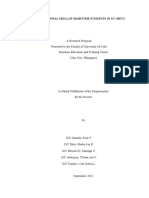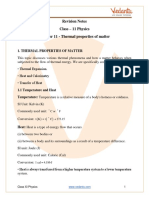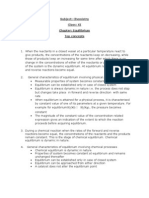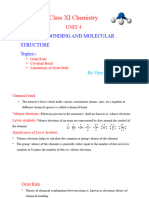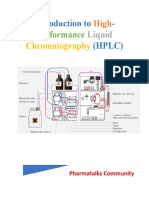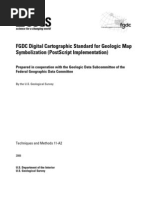Class 11 Revision Notes Probability
Uploaded by
Ashwath KuttuvaClass 11 Revision Notes Probability
Uploaded by
Ashwath KuttuvaRevision Notes
Class - 11 Maths
Chapter 16 - Probability
● Probability is a numerical measure of the uncertainty of diverse phenomena.
It can range from 0 to 1 a positive value.
● The phrases 'probably', 'doubt’, ‘most probably', 'chances' and so on, all have
an element of ambiguity in them.
no. of favourable outcome
● Probability=
total no. of outcomes
● Approaches to Probability:
i. Statistical approach: Observation & data collection
ii. Classical approach: Only Equal probable events
iii. Axiomatic method: For real-life situations. It has a strong connection to set
theory.
● Random Experiments:
(i) There are multiple possible outcomes.
(ii) It is impossible to know the outcome ahead of time.
● Outcomes: An outcome is a probable result of a random experiment.
● Sample space refers to the set of all possible results of a random experiment.
The letter S stands for it. For example, in a coin toss, the sample space is Head,
Tail.
Each element of the sample space is referred to as a sample point. For
example, in a coin flip, the head is a sample point.
Class XI Maths www.vedantu.com 1
● Event:
An event is a collection of favourable outcomes.
An event is defined as a subset E of a sample space S . For example, suppose you
get an unusual result when you roll a dice.
● Occurrence of an event:
The occurrence of an event E in a sample space S is said to have occurred if the
experiment's outcome is such that E . We say that the event E did not
happen if the outcome is such that E .
● Types of Event
i. Impossible and Sure Events
ii. Simple Event
iii. Compound Event
● Impossible and Sure Events:
Events that are both impossible and certain are described by the empty set
and the sample space S . The impossible event is denoted by , and the entire
sample space is referred to as the Sure Event.
For example, while rolling a dice, an impossible event is when the number is
greater than 6 and a sure event is when the number is less than or equal to 6.
● Simple (or elementary) event: A simple event has only one sample point of a
sample space.
There are exactly n simple occurrences in a sample space with n different
items. For example, if you roll a dice, a simple event could be receiving a four.
Class XI Maths www.vedantu.com 2
● Compound Event: A compound event is one in which there are multiple
sample points.
For example, in the case of rolling a die, a simple event could be the event of
receiving a four.
● Algebra of Events:
i. Complementary Event
ii. Event ‘A or B’
iii. Event ‘A and B’
iv. Event ‘A but not B
● Complementary Event
Complementary event to A='not A'
Example: If event A= Event of getting odd number in throw of a die, that is
1, 3, 5 Then, Complementary event to A= Event of getting even number in
throw of a die, that is 2, 4, 6
A'=ω:ω S and A S A (Where S is the Sample Space)
● Event (A or B):
A B is known as the union of two sets A and B , it contains all those elements
which are present in either of the two sets.
Class XI Maths www.vedantu.com 3
If the sets A and B correspond to two events in a sample space, then ‘A B’ is
the event ‘either A or B or both’. This event ‘A B’ is also called ‘A or B’
Event
● Event 'A and B' :
A B is known as the intersection of two sets A and B , it contains all those
elements which are common in both the two sets. i.e., which belong to both
‘A and B’ . If A and B are two events, then the set A A B denotes the event
‘A and B’ .
Thus, A B = {ω : ω A and ω B}
● Event 'A but not B'
A–B is the set of all those elements which are in A but not in B . Therefore, the
set A–B may denote the event ‘ A but not B ’.
Class XI Maths www.vedantu.com 4
A – B = A B'
● Mutually exclusive events
Events A and B are said to be mutually exclusive if the occurrence of one of
them precludes the occurrence of the other, i.e., if they can't happen at the same
time.
A die is thrown, for example. All even outcomes is event A , and all odd outcomes
is event B . Then A and B are mutually exclusive events, and they cannot happen
at the same time.
A sample space's simple events are always mutually exclusive.
● Exhaustive events:
Sample space contains lot of events together.
Example: A die is thrown.
Event A= All even outcome and event B= All odd outcome. Even A & B
together forms exhaustive events as it forms Sample Space.
● Axiomatic Approach to Probability:
Another way of explaining probability by using axioms are rules is called the
Axiomatic approach.
Let S be sample space of a random experiment. The probability P is a real
Class XI Maths www.vedantu.com 5
valued function whose domain is the power set of S and range is the interval 0,1
satisfying the following axioms
I. For any event E, P E 0
II. P S 1
III. If E and F are mutually exclusive events, then P E F P E P F
It follows from (III) that P =0 . Let F= and E= be two disjoint events,
P E P E P or P E P E +P i.e P =0
Let S be a sample space containing outcomes 1 , 2 ,....n i.e., S 1 , 2 ....., n
then
I. 0 P i 1 for each ωi S
II. P 1 P 2 .... P n 1
III. For any event E,P E P i , i A
IV. P 0
● Probabilities of equally likely outcomes:
1
Let P ωi = p , for all ωi S where 0 p 1 , then p where n= number of
n
elements.
Let S be a sample space and E be an event, such that n S =n and n E m . If
m
each outcome is equally likely, then it follows that P E =
n
Number of outcomes favourable to E
Total possible outcomes
Class XI Maths www.vedantu.com 6
● Probability of the event ‘ A or B’ :
P(A B) = P A + P B - P A B
● Probability of the event ‘A and B’ :
P A B = P A + P B - P A B
● Probability of the event ‘Not A ’
P A' = P not A = 1 – P A
Class XI Maths www.vedantu.com 7
You might also like
- Interpersonal Skills of Maritime StudentsNo ratings yetInterpersonal Skills of Maritime Students35 pages
- Thinking in Bets: Making Smarter Decisions When You Don't Have All The Facts - Book Notes92% (12)Thinking in Bets: Making Smarter Decisions When You Don't Have All The Facts - Book Notes15 pages
- Art of Public Speaking Chapter SummariesNo ratings yetArt of Public Speaking Chapter Summaries23 pages
- Class 11 Chemistry Notes 2023 24 Chapter 1 Some Basic Concepts ofNo ratings yetClass 11 Chemistry Notes 2023 24 Chapter 1 Some Basic Concepts of45 pages
- Oswaal CBSE Class 11th Mind Map English Core For 2022 ExamNo ratings yetOswaal CBSE Class 11th Mind Map English Core For 2022 Exam6 pages
- Previous Years How Do Orgnisms Reproduce Shobhit Nirwan100% (1)Previous Years How Do Orgnisms Reproduce Shobhit Nirwan6 pages
- 01 Some Basic Concept of Chemistry Formula Sheets100% (1)01 Some Basic Concept of Chemistry Formula Sheets8 pages
- Mechanical Properties of Solids: ElasticityNo ratings yetMechanical Properties of Solids: Elasticity12 pages
- Class 11 Physics Revision Notes Thermal Properties of MatterNo ratings yetClass 11 Physics Revision Notes Thermal Properties of Matter16 pages
- Class 11 Physics Notes 2023-24 Chapter 3 Motion in A Straight Line100% (2)Class 11 Physics Notes 2023-24 Chapter 3 Motion in A Straight Line33 pages
- Waves Class 11 Notes Physics Chapter 15 - Learn CBSENo ratings yetWaves Class 11 Notes Physics Chapter 15 - Learn CBSE9 pages
- Padhle 10th - Human Eye & The Colourful World + Integrated PYQs100% (1)Padhle 10th - Human Eye & The Colourful World + Integrated PYQs18 pages
- Relations and Functions - Class Notes - VIJETA SERIES CLASS-12THNo ratings yetRelations and Functions - Class Notes - VIJETA SERIES CLASS-12TH165 pages
- Sequences and Series - Formula Sheet - MathonGo100% (1)Sequences and Series - Formula Sheet - MathonGo6 pages
- Notes - Class 11 CBSE NCERT - Chemistry Chapter 1 - Some Basic Concepts of ChemistryNo ratings yetNotes - Class 11 CBSE NCERT - Chemistry Chapter 1 - Some Basic Concepts of Chemistry17 pages
- Chemical Bonding and Molecular Structure - Class 11No ratings yetChemical Bonding and Molecular Structure - Class 1117 pages
- CBSE Class 11 Chemistry Notes CH - 02 Structure of Atom40% (5)CBSE Class 11 Chemistry Notes CH - 02 Structure of Atom6 pages
- Padhle 10th - Periodic Classification of Elements + Integrated PYQsNo ratings yetPadhle 10th - Periodic Classification of Elements + Integrated PYQs40 pages
- Basic Concepts of Chemistry Notes - Class 11 JEE33% (3)Basic Concepts of Chemistry Notes - Class 11 JEE18 pages
- Fluid Mechanics (FM) Hand Written Notes For Class 11 Jee100% (1)Fluid Mechanics (FM) Hand Written Notes For Class 11 Jee77 pages
- THERMAL PROPERTIES OF MATTER NCERT Highlights0% (1)THERMAL PROPERTIES OF MATTER NCERT Highlights25 pages
- Class 11 Chemistry Revision Notes Organic ChemistryNo ratings yetClass 11 Chemistry Revision Notes Organic Chemistry26 pages
- Class 11 Maths Relation and Functions NotesNo ratings yetClass 11 Maths Relation and Functions Notes17 pages
- Physics Notes Class 11 Chapter 3 Motion in A Straight LineNo ratings yetPhysics Notes Class 11 Chapter 3 Motion in A Straight Line9 pages
- Science Class 9 Notes Diversity in Living OrganismsNo ratings yetScience Class 9 Notes Diversity in Living Organisms3 pages
- 12th HSC Geography Full Exercise Solutions-WatermarkedNo ratings yet12th HSC Geography Full Exercise Solutions-Watermarked80 pages
- Chemistry The D and F Block Elements PDFNo ratings yetChemistry The D and F Block Elements PDF29 pages
- Some Basic Concepts of Chemistry - Shobhit Nirwan100% (1)Some Basic Concepts of Chemistry - Shobhit Nirwan10 pages
- XI Chem Ch7 Equilibrium Chapter Notes NovNo ratings yetXI Chem Ch7 Equilibrium Chapter Notes Nov10 pages
- Class 11 Chapter 4 Chemical Bonding and Molecular Structure100% (1)Class 11 Chapter 4 Chemical Bonding and Molecular Structure139 pages
- E.G. in Rolling A Die, Impossible Event Is ThatNo ratings yetE.G. in Rolling A Die, Impossible Event Is That3 pages
- Study Materials: Vedantu Innovations Pvt. Ltd. Score High With A Personal Teacher, Learn LIVE Online!No ratings yetStudy Materials: Vedantu Innovations Pvt. Ltd. Score High With A Personal Teacher, Learn LIVE Online!6 pages
- Chap 16 Probability - KmuaqpbcqhofilpqboxdNo ratings yetChap 16 Probability - Kmuaqpbcqhofilpqboxd6 pages
- Probability: OR Probability Is The Extent To Which Something Is Likely To HappenNo ratings yetProbability: OR Probability Is The Extent To Which Something Is Likely To Happen6 pages
- A Test of Protection Motivation Theory in The Information SecuritNo ratings yetA Test of Protection Motivation Theory in The Information Securit42 pages
- Tian Et Al (2019) What Factors Affect Consumers' Dining Sentiments and Their Ratings-Evidence From Restaurant Online Review DataNo ratings yetTian Et Al (2019) What Factors Affect Consumers' Dining Sentiments and Their Ratings-Evidence From Restaurant Online Review Data9 pages
- Architectural Variation, Building Height, and The Restorative Quality of Urban Residential StreetscapesNo ratings yetArchitectural Variation, Building Height, and The Restorative Quality of Urban Residential Streetscapes11 pages
- Affect Matters Going Beyond Rational Decision Making Processes To Understand Social Acceptance of Renewable Energy Sources PDFNo ratings yetAffect Matters Going Beyond Rational Decision Making Processes To Understand Social Acceptance of Renewable Energy Sources PDF204 pages
- An Investigation of The Efficacy and Effectiveness of Using Bilingualism As A Medium of Instruction in Different Educational LevelsNo ratings yetAn Investigation of The Efficacy and Effectiveness of Using Bilingualism As A Medium of Instruction in Different Educational Levels25 pages
- Bootstrap Confidence Interval of the Difference Between Two Process Capability IndicesNo ratings yetBootstrap Confidence Interval of the Difference Between Two Process Capability Indices8 pages
- Project - Final Assignment C - Student Guide 2No ratings yetProject - Final Assignment C - Student Guide 23 pages
- Sample Safety Health and Environmental Manual100% (1)Sample Safety Health and Environmental Manual13 pages
- Doing Quantitative Research in Education with SPSS 1st Edition Dr Daniel Muijs download pdf100% (9)Doing Quantitative Research in Education with SPSS 1st Edition Dr Daniel Muijs download pdf60 pages
- 14.740x: Foundations of Development Policy: IntructorsNo ratings yet14.740x: Foundations of Development Policy: Intructors10 pages
- Read The Article and Answer The Following QuestionsNo ratings yetRead The Article and Answer The Following Questions10 pages
- FGDC Digital Cartographic Standard For Geologic MapNo ratings yetFGDC Digital Cartographic Standard For Geologic Map263 pages
- Manegerial Accounting Project - Yousef HalasehNo ratings yetManegerial Accounting Project - Yousef Halaseh9 pages
- Factors Influencing Preferences of Tourists on Public and Private ResortsNo ratings yetFactors Influencing Preferences of Tourists on Public and Private Resorts29 pages
- Thinking in Bets: Making Smarter Decisions When You Don't Have All The Facts - Book NotesThinking in Bets: Making Smarter Decisions When You Don't Have All The Facts - Book Notes
- Class 11 Chemistry Notes 2023 24 Chapter 1 Some Basic Concepts ofClass 11 Chemistry Notes 2023 24 Chapter 1 Some Basic Concepts of
- Oswaal CBSE Class 11th Mind Map English Core For 2022 ExamOswaal CBSE Class 11th Mind Map English Core For 2022 Exam
- Previous Years How Do Orgnisms Reproduce Shobhit NirwanPrevious Years How Do Orgnisms Reproduce Shobhit Nirwan
- Class 11 Physics Revision Notes Thermal Properties of MatterClass 11 Physics Revision Notes Thermal Properties of Matter
- Class 11 Physics Notes 2023-24 Chapter 3 Motion in A Straight LineClass 11 Physics Notes 2023-24 Chapter 3 Motion in A Straight Line
- Waves Class 11 Notes Physics Chapter 15 - Learn CBSEWaves Class 11 Notes Physics Chapter 15 - Learn CBSE
- Padhle 10th - Human Eye & The Colourful World + Integrated PYQsPadhle 10th - Human Eye & The Colourful World + Integrated PYQs
- Relations and Functions - Class Notes - VIJETA SERIES CLASS-12THRelations and Functions - Class Notes - VIJETA SERIES CLASS-12TH
- Notes - Class 11 CBSE NCERT - Chemistry Chapter 1 - Some Basic Concepts of ChemistryNotes - Class 11 CBSE NCERT - Chemistry Chapter 1 - Some Basic Concepts of Chemistry
- Chemical Bonding and Molecular Structure - Class 11Chemical Bonding and Molecular Structure - Class 11
- CBSE Class 11 Chemistry Notes CH - 02 Structure of AtomCBSE Class 11 Chemistry Notes CH - 02 Structure of Atom
- Padhle 10th - Periodic Classification of Elements + Integrated PYQsPadhle 10th - Periodic Classification of Elements + Integrated PYQs
- Fluid Mechanics (FM) Hand Written Notes For Class 11 JeeFluid Mechanics (FM) Hand Written Notes For Class 11 Jee
- Class 11 Chemistry Revision Notes Organic ChemistryClass 11 Chemistry Revision Notes Organic Chemistry
- Physics Notes Class 11 Chapter 3 Motion in A Straight LinePhysics Notes Class 11 Chapter 3 Motion in A Straight Line
- Science Class 9 Notes Diversity in Living OrganismsScience Class 9 Notes Diversity in Living Organisms
- 12th HSC Geography Full Exercise Solutions-Watermarked12th HSC Geography Full Exercise Solutions-Watermarked
- Class 11 Chapter 4 Chemical Bonding and Molecular StructureClass 11 Chapter 4 Chemical Bonding and Molecular Structure
- Study Materials: Vedantu Innovations Pvt. Ltd. Score High With A Personal Teacher, Learn LIVE Online!Study Materials: Vedantu Innovations Pvt. Ltd. Score High With A Personal Teacher, Learn LIVE Online!
- Probability: OR Probability Is The Extent To Which Something Is Likely To HappenProbability: OR Probability Is The Extent To Which Something Is Likely To Happen
- A Test of Protection Motivation Theory in The Information SecuritA Test of Protection Motivation Theory in The Information Securit
- Tian Et Al (2019) What Factors Affect Consumers' Dining Sentiments and Their Ratings-Evidence From Restaurant Online Review DataTian Et Al (2019) What Factors Affect Consumers' Dining Sentiments and Their Ratings-Evidence From Restaurant Online Review Data
- Architectural Variation, Building Height, and The Restorative Quality of Urban Residential StreetscapesArchitectural Variation, Building Height, and The Restorative Quality of Urban Residential Streetscapes
- Affect Matters Going Beyond Rational Decision Making Processes To Understand Social Acceptance of Renewable Energy Sources PDFAffect Matters Going Beyond Rational Decision Making Processes To Understand Social Acceptance of Renewable Energy Sources PDF
- An Investigation of The Efficacy and Effectiveness of Using Bilingualism As A Medium of Instruction in Different Educational LevelsAn Investigation of The Efficacy and Effectiveness of Using Bilingualism As A Medium of Instruction in Different Educational Levels
- Bootstrap Confidence Interval of the Difference Between Two Process Capability IndicesBootstrap Confidence Interval of the Difference Between Two Process Capability Indices
- Doing Quantitative Research in Education with SPSS 1st Edition Dr Daniel Muijs download pdfDoing Quantitative Research in Education with SPSS 1st Edition Dr Daniel Muijs download pdf
- 14.740x: Foundations of Development Policy: Intructors14.740x: Foundations of Development Policy: Intructors
- Read The Article and Answer The Following QuestionsRead The Article and Answer The Following Questions
- FGDC Digital Cartographic Standard For Geologic MapFGDC Digital Cartographic Standard For Geologic Map
- Factors Influencing Preferences of Tourists on Public and Private ResortsFactors Influencing Preferences of Tourists on Public and Private Resorts
